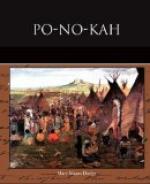VI.
KA-TE-QUA.
All that night, and for many days afterward, Tom lay in a burning fever, quite unconscious of what was passing around him.
Meanwhile, strange to say, Rudolph and Kitty were treated almost with kindness. They were well fed, and were given the softest deer-skins to lie upon at night. Finding themselves unharmed as the hours went on, the little creatures became more confident, and finally resumed their natural playfulness.
Kitty was never weary of the bright beads and ornaments of the Indian maidens, and Rudolph found great delight in shooting with the bows and arrows of the papooses or children, who, in turn, were wonderfully amused at the bad shots of the little pale-face. Now and then, to be sure, the vicious child of some chieftain would amuse itself by pricking Kitty’s tender skin with a thorn, and hearing her scream in consequence; or, having seen the black-and-blue marks upon her delicate arms, caused by the rough handling of her captors, they would pinch her flesh and watch for the change of color with intense interest. One day they tried it while Rudolph was standing by, holding the hand of the squaw who had him in charge. No sooner did the usual scream escape Kitty’s lips than, quick as thought, the boy broke from the woman’s grasp, and, rushing upon his sister’s tormentor, laid the little savage in the dust and pummeled him well. Instead of resenting this, the Indians seemed to admire the pluck of the young pale-face, and he rose in their favor at once. Especially did the old squaw, as Indian women are called, applaud him. She was a strange old creature, named Ka-te-qua (female eagle), and, being half crazy, was looked upon by the Indians as one inspired by Manitou, or the Great Spirit. Besides, her brother had been a famous Medicine-man[1] of the tribe; and her two sons, who had been slain in battle, were celebrated braves or warriors, each owning long chains of scalps, which they had taken from their enemies. So, of course, when she wagged her head in approbation of Rudolph’s conduct, all the women near her wagged their heads also. Indeed, had Tom remained ill a few weeks longer, the black marks on the children’s faces would have worn off without any further injury being done them. But as he grew better, and, finally, was able to sit upright on his deer-skin couch, the malice of his captors was renewed. They resolved not only to carry out the sentence upon the children, but to put the sick pale-face to new tortures as soon as he was strong enough to afford them the requisite amount of sport on the occasion. Accordingly on the fourth day after Rudolph had punished the little “Red-skin,” preparations were begun. Heaps of fagots were industriously piled against an oak tree, which stood apart. Tom, with feet shackled, and his arms tightly secured to his sides, was led out to witness the fearful scene. Rudolph and Kitty were seized, and, in spite of their struggles, bound side by side to the tree.




